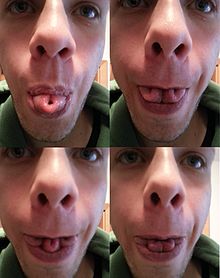Tongue rolling

Tongue rolling is the ability to roll the lateral edges of the tongue upwards into a tube. The tongue's intrinsic muscles allow some people to form their tongues into specific shapes. Rolling the tongue into a tube shape is often described as a dominant trait with simple Mendelian inheritance, and it is commonly referenced in introductory and genetic biology courses.[1]
There is little laboratory evidence supporting the hypothesis that tongue rolling is inheritable and dominant. In 1940, Alfred Sturtevant observed that ~70% of people of European ancestry could roll their tongues and the remaining ~30% could not do it.[2] A 1975 twin study found that identical twins were no more likely than fraternal twins to both have the same phenotype for tongue rolling.[3]

Cloverleaf tongue is the ability to fold the tongue in a certain configuration with multiple bends. This trait has been speculated by David D. Whitney to be a dominant trait inherited separately from tongue rolling.[3]
See also
References
- ^ Mader S. S. (2000): Human biology. McGraw-Hill, New York, ISBN 0-07-290584-0; ISBN 0-07-117940-2.
- ^ Utah. "Observable Human Characteristics". Retrieved 26 January 2015.
- ^ a b Omim - Tongue Curling, Folding, Or Rolling
External links
- OMIM - Tongue Curling, Folding, Or Rolling
